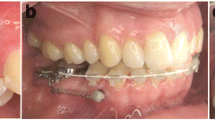Abstract
Aim:
A questionnaire was sent to orthodontists with private practices in the German State of Hesse to obtain information about the frequency of rapid palatal expansion and complications during treatment with rapid palatal expansion appliances (RPE-A).
Material and Method:
A series of questions therein inquired as to the types of RPE-As used, their activation rhythm, the extent and the duration of the active expansion and retention; what their age limit was, starting from when surgical assistance was deemed necessary. Another series of queries concerned any technical and medical complications observed.
Results:
The most frequently used type was the Hyrax screw (75%) soldered to bands. Technical problems arose with all applied indicated types. Although the answers to the first series of questions showed great variance, the majority of the orthodontists activated the screw twice a day (range 1–6 times a day) by a quarter turn for 2–3 (range 1–12) weeks. The retention phase amounted to 12 (range 4–26) weeks and the age limit for the indication of a surgical intervention was on average 17 years, with a range of 10–35 years. Medical complications such as pain and decubitae were reported by a third of the inquired offices, a non-opening suture was observed in one of every five practices. This meant that 1.7% of the sutures failed to open, and tooth tilting and rarely, extreme root resorptions and/or bone dehiscences were observed. Solid carious lesions were observed in one case after removal of an adhesive RPE. Extraoral changes such as those in the nose were reported by one in every ten practices.
Conclusions:
The RPE represents a common treatment means during which side effects are often temporary and permanent damages rather rare. It is important to inform the patient about both positive effects and possible complications, in particular pain and extraoral changes.
Zusammenfassung
Ziel:
In einer Umfrage unter hessischen Kieferorthopäden wurden Erhebungen über die Häufigkeit der Gaumennahterweiterung und die Komplikationen während einer Behandlung mittels Gaumennahterweiterungsapparaturen (GNE-A) durchgeführt.
Material und Methode:
Ein Fragenkomplex beinhaltete dabei Fragen zu den verwendeten Typen von GNE-Apparaturen, ihrem Aktivierungsrhythmus, dem Ausmaß und der Dauer der aktiven Dehnung und der Retentionszeit; außerdem wurde die Altersgrenze erfragt, ab wann eine chirurgische Unterstützung für notwendig erachtet wird. Ein anderer Komplex befasste sich mit den beobachteten technischen und medizinischen Komplikationen.
Ergebnisse:
Der am meisten verwendetete Typ war die an Bändern verlötete Hyraxschraube (75%). Technische Probleme traten bei allen angegebenen Typen auf. Obwohl bei den Antworten zum ersten Fragenblock eine große Varianz festgestellt wurde, ließ die Mehrheit der Behandler 2×/Tag (1–6×/Tag) eine Viertelumdrehung der Schraube für 2–3 (1–12) Wochen aktivieren. Die Retentionszeit betrug 12 (4–26) Wochen und als Altersgrenze für eine chirurgische Intervention wurden im Mittel 17 Jahre bei einer Spannbreite von 10–35 Jahren angegeben. Medizinische Komplikationen wie Schmerzen und Dekubitus gaben ein Drittel der befragten Praxen an, eine sich nicht öffnende Naht wurde in jeder fünften Praxis beobachtet. Dies bedeutete, dass 1,7% der Suturen sich nicht öffnen ließen und neben Zahnkippungen auch in seltenen Fällen extreme Wurzelresorptionen bzw. Knochendehiszenzen beobachtet wurden. In einem Fall wurden nach Entfernung einer geklebten GNE massive kariöse Läsionen festgestellt. Extraorale Veränderungen wie z. B. Auffälligkeiten an der Nase wurden in jeder zehnten Praxis beobachtet.
Schlussfolgerungen:
Die GNE stellt eine gängige Behandlungsmethode dar, wobei Nebenwirkungen oft temporär und Dauerschäden eher selten waren. Wichtig ist, bei der Patienteninformation nicht nur auf die positiven Effekte, sondern auch auf mögliche Komplikationen, insbesondere Schmerzen und extraorale Veränderungen, hinzuweisen.
Similar content being viewed by others
Author information
Authors and Affiliations
Corresponding author
Rights and permissions
About this article
Cite this article
Schuster, G., Borel-Scherf, I. & Schopf, P.M. Frequency of and Complications in the Use of RPE Appliances—Results of a Survey in the Federal State of Hesse, Germany. J Orofac Orthop 66, 148–161 (2005). https://doi.org/10.1007/s00056-005-0431-6
Received:
Accepted:
Issue Date:
DOI: https://doi.org/10.1007/s00056-005-0431-6




